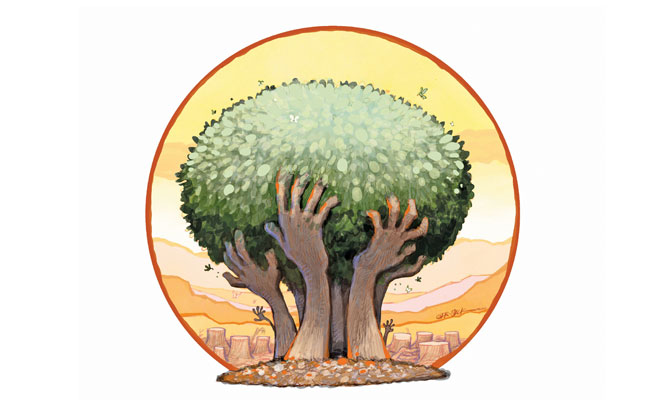
Trees, forests and sustainable forestry can help the world recover from the COVID-19 pandemic and combat looming environmental crises such as climate change and biodiversity loss. But this requires societies to better recognise the considerable value of forests and their crucial roles in building inclusive, resilient and sustainable economies.
There are three pathways along which societies, communities and individual landowners, users and managers can derive more tangible value from forests and trees while addressing environmental degradation, preventing future pandemics, increasing resilience and transforming economies.
These are:
- Halting deforestation and maintaining forests. This could avoid emitting between two gigatons (Gt) and 3,6Gt of carbon dioxide equivalent (GtCO2e) per year between 2020 and 2050, including about 14% of what is needed up to 2030 to keep planetary warming below 1,5°C, while safeguarding more than half the earth’s terrestrial biodiversity.
- Restoring degraded lands and expanding agroforestry. About 1,5 billion hectares of degraded land would benefit from restoration, and increasing tree cover could boost agricultural productivity on another one billion hectares. Restoring degraded land through afforestation and reforestation could cost-effectively take between 0,9 GtCO2e and 1,5 GtCO2e per year out of the atmosphere between 2020 and 2050.
- Sustainably using forests and building green value chains. This would help meet future demand for materials (with global consumption of all natural resources expected to more than double from 92 billion tons in 2017 to 190 billion tons in 2060), and underpin sustainable economies.
The role of smallholders
Smallholders, local communities and indigenous peoples own or manage nearly half (4,35 billion hectares) of the world’s forest and farm landscapes and will be crucial for scaling up implementation of the pathways. The involvement of smallholders, local communities and indigenous peoples in the forest pathways is essential for various reasons.
Firstly, family farmers account for 80% of global food production, and those holding less than 2ha of land account for 35%. In many countries, up to 90% of forest enterprises are small or medium-sized; such enterprises generate more than half of forest-related employment.
Secondly, according to one study, smallholders produce farm and forest products worth between US$869 billion and US$1,29 trillion (between about R15 trillion and R22,3 trillion) a year.
Thirdly, there is evidence that, in general, smallholders with secure tenure tend to make longer-term investments in their lands and forests than those with short-term or no security.
Finally, studies show that 91% of all indigenous and community lands are in good or moderate ecological condition, pointing to their potential for cost-effectively reducing deforestation and improving forests. For example, securing indigenous lands in some countries in Latin America would cost less than 1% of potential revenues from carbon storage alone.
Strengthening local capacity
Contemporary approaches to forest education include extension, farmer-field-school interaction, peer-to-peer exchanges and business incubation to provide smallholders, local forest-based businesses, local communities, indigenous peoples and forest workers with learning opportunities and access to technical support.
These approaches strengthen local capacity and innovation. In many countries, however, forestry extension services have been weakened due to financial, political and structural constraints.
Existing extension and development programmes are often rooted in technocentric approaches focused on preselected “best practices” that treat forest communities as passive learners. In addition, they rarely involve farmers and local knowledge-holders in training and therefore fail to address knowledge needs and gaps adequately.
Fortunately, opportunities exist to shift this paradigm. They involve strengthening forest knowledge and innovation, and increasing the role of farmers and indigenous peoples in sustainable forestry, the integration of trees in agriculture and related value-chain and business development.
For them to succeed, investment is needed to bring back forest extension programmes
that use people-centred approaches and aim to co-produce knowledge and develop soft skills, such as through farmer field schools. Learning-by-doing approaches in community-based forestry, such as those in Brazil and Indonesia, also show promise.
Many smallholders, local communities, indigenous peoples and their organisations would benefit from additional support to innovate and gain greater access to value chains and markets via digital tools, co-operation and public-private partnerships.
Market closures and restrictions due to the COVID-19 pandemic have demonstrated the importance of digital tools and online marketing for rural producers.
With adequate support, such as capacity development in financial and organisational management, marketing and design, conducive procurement policies, and access to certification schemes and new markets, smallholder farmers and producers could gain the skills, knowledge and means needed to overcome market barriers and establish profitable businesses and sustainable livelihoods.
Public-private partnerships have demonstrated positive impacts in timber and non-timber forest production, forest conservation and reducing deforestation.
Approaches that combine traditional and scientific knowledge and new technologies show promise, but challenges remain in bridging scientific and traditional knowledge systems.
These include a lack of tools and approaches that reflect divergent world views, identities, practices, ethics and asymmetries of power and rights.
A recent report mapping eight indigenous peoples’ food systems, including those in forested landscapes, noted a total absence of educational programmes that are built on indigenous values, beliefs and traditions in studied sites. Considerable work is needed to develop approaches that incorporate traditional knowledge into formal and informal forest education.
Supportive policies are needed to enable forest curricula development based on solid partnerships, participatory processes and ethical engagement with traditional knowledge-holders and institutions. Forest education at all levels must be culturally and ecologically relevant to the needs of the people concerned to diminish the disconnection between the acquiring of knowledge and its local-level application.
Digital tools
Government services and other tools are increasingly moving online; this is a general trend driven by technology and economies of scale. Smallholders, local communities and indigenous peoples are benefitting from the increased availability of digital tools such as smartphone apps and remote-sensing, which improve access to information.
This entails forest monitoring, e-learning, weather forecasting, extension and advisory services, real-time field data collection, finance (for example, payments and digital credit records), business relationships (including online marketing platforms) and markets (for example, Internet connections, voice and text messaging, and digital platforms for product traceability).
Nonetheless, access to these is often a challenge in rural areas. Given the global trend of moving online, including rural communities in this ‘digital nation’ is becoming imperative. The absence of means for participation could block the development of the entire forest sector.
A lack of coverage is a major reason the sector remains relatively conventional and the development and uptake of innovation has been slow, despite the considerable potential benefits that exist.
The views expressed in our weekly opinion piece do not necessarily reflect those of Farmer’s Weekly.
This is an edited excerpt from a Food and Agriculture Organization of the United Nations’ report titled ‘The state of the world’s forests 2022’.











